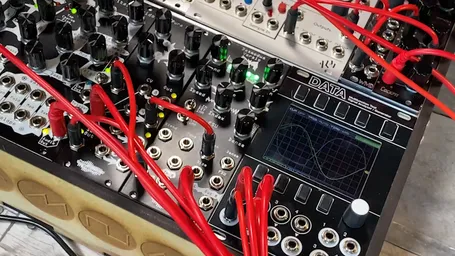Markus here again. I’ve just returned from a brief hiatus after being lost deep in the woods. It was a harrowing adventure, and I barely escaped with my life. But, being the natural-born survivalist that I am [Editor’s note: guffaw], I’ve returned against all odds and am here once again with some more synthesis tips and tricks to help you along in your modular endeavors. [Editor’s note: Markus went camping for three days. The most “harrowing” part of their trip was running out of creamer for their morning coffee at the campsite. Oh the humanity!]
This week, we’ll be talking about some basic tips for tuning your NE oscillators. We get a lot of questions about this -- basically, some of our oscillators are easier to tune than others. In this post, we talk about basic tuning strategies, why some oscillators just don’t seem to want to tune, and some ways (including knob settings) to make it easier.
A brief note on basic tuning strategies...or why is it so hard?
Tuning can be difficult for a lot of reasons. If you’re trying to tune by ear and you’re just starting out, it can seem darn near impossible! But don’t lose hope. Tuning by ear is a thing, but by no means the only method out there. You’re not cheating if you use a tuner; a lot of pros still use tuners!
There are many ways to tune a system for melodic music. My favorite strategy is to use something like Soleo Vero, our three-channel stroboscopic tuner. You can also tune a system via a reference pitch: either using a dedicated reference tone from something like a Mordax Data and tuning your oscillators to match that pitch, or just find a note you like on an oscillator and tune the rest of your system to match those (more on this strategy in a bit). With some practice, it becomes quite quick.
Once you have your method, you may still struggle for a variety of reasons. Fear not. We are here to help. Below, we’ll walk through all our oscillators, the hurdles you may run across, and ways around them.
Number one tip: Parameters don’t matter
That’s right, parameter knobs don’t change tuning, but they can make it hard to hear what you’re doing. Octaves don’t either (well, ok, they shift your pitch by two octaves on modules with a B/A/T switch). So our biggest tip that unifies all of these will be to 1. Turn off any modulation you have going in, 2. find the sweet spot in the parameter knobs (more on that below), and 3. tune!
Starting out small: AT, SI
These two are easy.
Ataraxic Translatron:
Set Tone fully counterclockwise, and set the switch to CV. Adjust the Pitch knob till you’re at your desired pitch. Easy enough!
Sinc Iter
Sinc Iter is easy to tune. Set Mode to Plain, then use the encoder in coarse mode to get near the note you want and then fine mode to dial it in. General tip for any oscillator: Saw waves are usually the easiest to tune.
SI also has a built-in quantizer, so once it’s in tune, it’s easy to keep it that way with whatever you’re sequencing it with!
Bigger but still easy: CI/P
Cursus Iteritas and its big sibling, Cursus Iteritas Percido, are both easy, too.
Cursus Iteritas
Turn all the parameters down. Carefully adjust the pitch knob until you’re in tune. This one’s a bit difficult since it uses a pot for tuning instead of an encoder, but with some fiddling you’ll get there. Using strategies like tapping the side of the pot instead of just twisting it can actually be very helpful.
Cursus Iteritas Percido
Basically the same idea as CI! Turn all the tonal parameters down. Set all the envelope sends to the 12 o’clock position. Set the Mode switch to Free so it acts like a normal oscillator. Press and turn the pitch encoder to get near the note you’re tuning to, then stop pressing and turn the encoder to fine-tune to the exact pitch you want.
Weirder noises: BIA, MI, and AI
These are a bit more complicated. Free-running oscillators give your tuner a lot more of a single pitch to “grab” onto, but modules with an internal envelope like BIA and MI can make tuning difficult. Add pitch modulation into the mix and you’re going to confuse the hell out of your poor tuner. For example, we get lots of questions from people struggling to tune the BIA with the pitch envelope on and the decay turned all the way down. This will be very, very hard to do.
Basimilus Iteritas Alter
Set the knobs like this for the easiest tuning:

Tap the HIT button repeatedly (or send it some trigs) and tune with the pitch knob. Skin is the easiest mode to tune in as there’s the least amount of pitch modulation going on, so it can be helpful to switch to this mode when tuning a sound, even if the sound you’re tuning uses another mode. If you want to know more about how the three modes modulate the sound internally, and why Skin is the best mode to tune in, check out the manual. Yes, you can tune in Skin mode and swap to a different mode -- the module will remain in tune!
Manis Iteritas:
With MI, you have the luxury of opening up the decay so it becomes free-running.
Set the knobs like this again for easy tuning:

Press and turn to get near the note you want, then unpress and turn to fine-tune and get the exact pitch you need. There are a LOT of things that mess with how pitch is perceived on MI, so this gets you close to a clean saw wave so it’s easy to tune like this.
Ataraxic Iteritas
AI is automatically free running -- and while there’s less pitch modulation happening here than in MI, there are still things that make our perception of pitch with the AI a bit weird. These settings make it easy:

Then just follow the same tuning procedure as MI.
Upping the complexity: LI/P
Loquelic Iteritas and Loquelic Iteritas Percido are weird because there are two oscillators and only one output. When I first got mine, I found tuning them both incredibly difficult, but there’s an easy trick to isolate the pitch of each.
Set the parameters like this:

On LIP, also set all four of the envelope sends to 12 o’clock (off), and Mode to Free.
Now for the cool part: switch Master to A. This lets us monitor the pitch of just the A oscillator as it’s syncing B and changing B’s pitch only gives us a tonal change, not a pitch change.
Tune A to roughly the note you want using the coarse tuning control, then dial it in with the fine tune control. Then, set Master to B, and tune B the same way. Super cool!
A quick demonstration: Tuning with SV, and tuning by ear
In this video, I’m going to tune Ataraxic Iteritas twice: once, using Soleo Vero, and once to another oscillator by ear. When done with SV, I basically just coarse tune until I’m near the target note and the lights slow down, then fine tune to get the lights as still as possible. (If a note is flat, the LEDs scroll up, so I turn the knob up. If a note is sharp, the LEDs scroll down, so I turn the knob down.)
When done by ear, I tune it near to the reference pitch, then use the oscillators’ “beating” (that wobbly sound that oscillators make when they’re tuned to near the same pitch) to tune them perfectly. The faster the wobbling, the more out of tune they are. The slower the wobbling, the closer to perfectly in tune. With some practice, it becomes second nature to tune like this!






